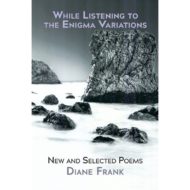 Diane Frank
Diane Frank
While Listening to the Enigma Variations: New and Selected Poems
Glass Lyre Press
Reviewed by Brian Fanelli
After the last few years of political tumult and after the year that was 2020, Diane Frank’s While Listening to the Enigma Variations: New and Selected Poems truly feels like a much-need respite, a booster shot if you will. Her poems are a celebration of all that’s good and right, be it music, art, nature, or the act of writing itself. Her poems, which often link personal memory or dreamscapes to the larger universe, are also a reminder to sing and to dance. It’s advice we could all use.
Frank, a cellist herself, has several poems that celebrate music, from the perspective of both performer and listener. Even if someone has never heard the concertos she mentions, there’s still something incredibly relatable and moving about the way that she describes music, especially the experience of listening to it. The style of music doesn’t matter, given the way she depicts the art form as a universal, transcendent experience. In “All Alone at the Orchestra,” she writes in the first stanza,
A small audience is gathered in the church.
A collection of musicians on the altar,
playing Mozart,
the velvet and the pulpit pushed aside.
I play on the second stand in the cello section,
the last molecule in the comet’s tail.
Does anyone understand the way I fly inside the music?
Surrounded by stained glass windows,
embracing the wood of old growth forests
in concert black and lace.
Music can be so awe-inspiring that Frank compares it to the cosmos. As a performer, she’s only a small part of something much bigger. The church setting creates a transcendent experience, too, especially when she asks, “Does anyone understand the way I fly inside the music?” Yet, she also connects herself to a much larger body, to something not fixed by time and space. This is evident when she links the stained glass windows to the wood of old growth forests and even compares herself to the “last molecule in a comet’s tale.” Music is a force in Frank’s poem that exists even beyond Earth.
In the second stanza, she continues the extended metaphor of the comet, writing, “I feel the movement in my back, my arms, my toes. / Then the comet in me flies off again. / Would anyone like to come along with me?” Eventually, the entire orchestra becomes part of this experience, all connected through the instruments and the music that they play, the song uplifting until her head is “an open cage, / an amphitheater / with skeletons of the winter trees.” Even if you’ve never been on stage, playing an instrument, or part of an ensemble as Frank describes, that feeling of being transported by music is a very human experience, even if you do it solely through a pair of headphones. Frank consistently captures the power of music and art in general.
The poet also has the eye of a photographer, in that she’s able to snap a short, moving scene, distilling a single moment. In fact, some of these poems are my favorite and offer as much as a few of her multi-page narratives. In just three verses, she wonderfully captures fall in the Midwest with “Autumn in Iowa”:
I stuff I Ching pennies
into a parking meter.
The sun tilts through colored glass,
turns blue in my kitchen window.
We put on costumes for Halloween.
I dance after midnight
with a bare-chested man
with boxing gloves.
The peony stalks are brittle
in the wind, and the coneflowers
have turned brown before November.
Field mice bury their fur
inside the quiet places of the heart.
Though “Autumn in Iowa” doesn’t tackle a major issue such as the transcendent power of music as “All Alone at the Orchestra” does, it’s still an evocative poem, underscoring Frank’s gift for documenting fine details. “Autumn in Iowa” is the type of poem that I’d show an intro to creative writing class to teach them about figurative language and concrete images. Yes, the poem only depicts one specific night, but the setting is rich, building to that potent last line that highlights the sadness of autumn and the gradual turning of the season to cold.
Frank is also gifted when it comes to celebrating life and honoring the dead. “Best Day Ever” is the perfect conclusion to her new and selected work, a poem in memory of her father that also serves as a reminder to all of us to be grateful that we’re alive. She writes of her dad,
Six years ago in the morning,
my father left this world.
Over time, his memory
became a source of strength to me,
and joy. I would have wanted him
to give me away at our wedding,
but maybe he was doing that
in a parallel, interpenetrating world.
Best Day Ever!
There’s a sense in much of Frank’s work that life carries on one way or the other, including the memories of the dead that we carry with us. Her poems also remind us not to take the little things for granted, like the color of the sky or a flash of light. The last stanza of “Best Day Ever” is a good sample of her work and the joy it can bring.
Back on Planet Earth,
I walk to the Post Office,
the thrift store, the bagel shop,
the fruit and vegetable stand.
and from that other world
I hear him whisper,
You were born to live in the City of Joy.
Every day, choose to walk there.
Back at home, rainbow over the ocean,
unexpected light.
Best Day Ever!
There’s nothing wrong with celebrating the good things in life, be it a concert or a rainbow over the ocean. Those moments and those details are at the center of Frank’s work. She also reminds us that we all inhabit this planet together, so it’s better to honor life than take it for granted or destroy it. While Listening to the Enigma Variations comes just at the right time, following a few very difficult years. Her poems remind readers to sing and celebrate because we’re still here. We’re alive.

